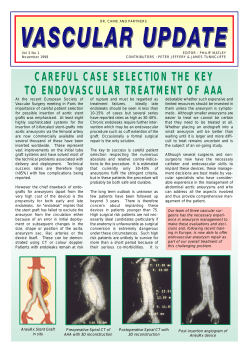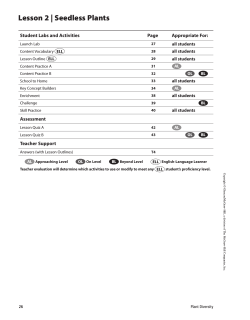
Evolution and Diversity of Plants
Chapter 24 Evolution and Diversity of Plants Outline Evolutionary History Alternation of Generations Nonvascular Plants Vascular Plants Seedless Seed Angiosperms - Monocots and Eudicots - Flowers Evolution and Diversity of Plants 2 Evolution and Diversity of Plants Evolutionary History of Plants More than 98% of all biomass is plants Multicellular photosynthetic eukaryotes Thought to have evolved from freshwater algae over 500 mya 3 4 Common Plants Today 5 Alternation of Generations 6 Evolution and Diversity of Plants Evolutionary History of Plants 1. Nonvascular Plants (Mosses) Advent of nourishment of a multicellular embryo within the body of the female plant 2. Seedless vascular plants (Ferns) Advent of vascular tissue 7 Nonvascular Plant Life Cycle Vascular Plants Evolution and Diversity of Plants Most seedless vascular plants are homosporous producing windblown capable spores which develop into hermaphrodite gametophytes • All seed plants are heterosporous and have male and female gametophytes 9 Seedless vascular plant life cycle Evolution and Diversity of Plants Evolutionary History of Plants 3. Gymnosperms and angiosperms (Conifers and Cicads) Produce seeds 4. Flowering Plants (Fruits and Flowers) Attract pollinators that give rise to fruits 11 Seed Plant Life Cycle Reduction in the Size of the Gametophyte 13 Nonvascular Plants Evolution and Diversity of Plants Nonvascular plants (Mosses -bryophytes) Lack specialized means of transporting water and organic nutrients Do not have true roots, stems, and leaves 14 Nonvascular Plants Evolution and Diversity of Plants Gametophyte is the dominant generation Sperm swim to egg in film of water to make zygote 15 Moss 16 Vascular Plants Evolution and Diversity of Plants Vascular tissue transports water and nutrients to the body of the plant Xylem conducts water and dissolved minerals up from roots Phloem conducts sucrose and other organic compounds throughout the plant 17 18 Leaf Vascular Tissue 19 20 C – 3 Plant C – 4 Plant CAM Plant Root Vascular Tissue 21 Root Vascular Tissue 22 Stem Vascular Tissue 23 Vascular Tissue 24 Seedless Vascular Plants Evolution and Diversity of Plants Seedless Vascular Plants (Ferns) Horsetails (phylum Sphenophyta) - Rhizome produces tall aerial stems 25 Fern (Horsetail) 26 Seed Plants Evolution and Diversity of Plants Seed plants are the most plentiful plants in the biosphere Seed coat and stored food allow an embryo to survive harsh conditions during long period of dormancy - Ovule develops into seed 27 Seed Plants: Gymnosperms Evolution and Diversity of Plants Gymnosperms have ovules and seeds exposed on the surface of sporophylls Conifers Cycads Ginkgoes 28 Gymnosperms 30 Gymnosperm diversity Evolution and Diversity of Plants Flowering Plants: Angiosperms Became dominant group of plants in the late Cretaceous and early Paleocene periods • Monocots and Eudicots 32 Monocots and Eudicots Evolution and Diversity of Plants Two classes of flowering plants Monocotyledones (Monocots) - One cotyledon (first leafs) in seed Eudicotyledones (Dicots) - Two cotyledons in seed 34 Monocot and Dicot Flower Parts petal sepal petal stamen stigma stamen pistil Trillium Monocot Flower Parts in Multiples of Three Cydonia oblonga (quince) Dicot Flower Parts in Multiples of Four or Five Monocot and Dicot Seedling Growth cotyledons Zea mays (corn) Phaseolus limensis (lima bean) Monocot One Cotyledon Dicot Two Cotyledons Monocot and Dicot Root Systems Zea mays (corn) Monocot Fibrous Root System Phytolacca americana (pokeweed) Dicot Taproot System Flower 38 Flowers and Diversification Evolution and Diversity of Plants Fruits of flowers protect and aid in dispersal Utilize wind, gravity, water, and animals for dispersal 39 Ground Tissue They function in • Photosynthesis • Storage • Regeneration • Support • Protection. Evolution and Diversity of Plants 40 Ground Tissue Evolution and Diversity of Plants The three types of ground tissue • Parenchyma • Collenchyma • Sclerenchyma 41 Plant Cells Evolution and Diversity of Plants Parenchyma • Generalized plant cell type • Palisade parenchyma Spongy mesophyll • irregularly shaped and have large intracellular spaces. 42 Plant Cells Evolution and Diversity of Plants Collenchyma • Specialized plant cell type • Helps support the plant • They tend to occur as part of vascular bundles • Thick cell walls 44 Collenchyma Plant Cells Evolution and Diversity of Plants Sclerenchyma • They often occur as bundle cap fibers • Helps support the plant • Thick cell walls that are hardened with the protein lignin 46 Sclerenchyma Ground Tissue 48
© Copyright 2025



















